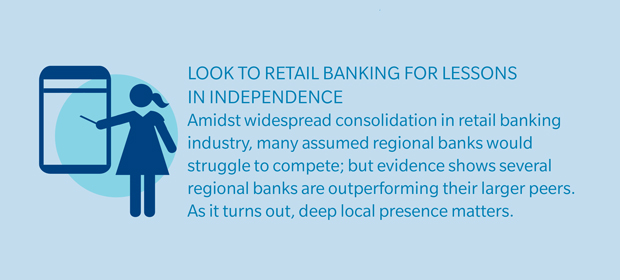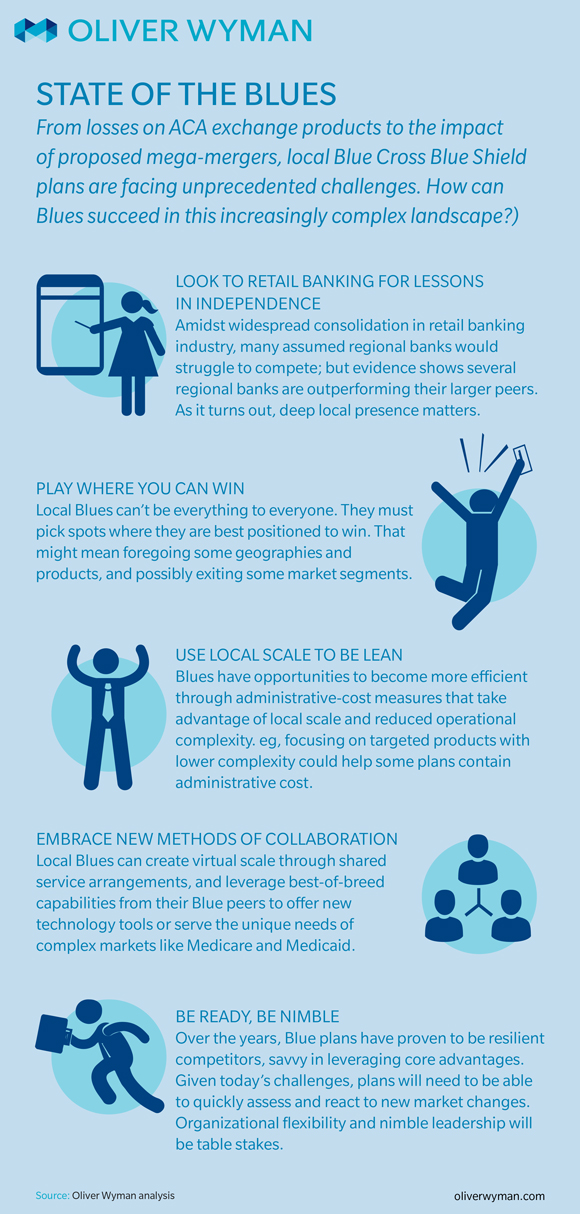Recent earnings declines (driven largely by ACA exchange losses), along with the uncertain impact of proposed mega-mergers, have many wondering about the continued viability of local Blue plans. Here, Oliver Wyman’s Todd Van Tol, Head of Health & Life Sciences for North America, and Jim Fields, Global Head of Health Services, offer their view on the future of local Blue plans, with insights into how Blue plans can navigate the current market pressures and chart a successful path forward:
Blue Cross Blue Shield (BCBS) plans play a vital role in the healthcare system, insuring more than 100 million consumers as 36 independent plans operating under a common brand. They also play an important role in the social fabric of their communities, acting as major employers, donors, and community members.
Over the years, the Blues have shown tremendous resilience in competing against larger competitors. Yet today, local Blue plans face a number of unprecedented challenges, including unprofitable ACA exchange business, the entrance of provider-owned health plans and well-funded innovators, and the looming impact of proposed national insurer mega-mergers.
The convergence of these challenges has many within and outside the BCBS system wondering about the future of local Blue plans, particularly smaller plans. And today’s difficult terrain raises questions about what it takes for Blues to succeed in this evolving landscape. We have identified five key areas where Blue plans can focus their path-forward efforts:
1) Evaluate Commitment to Sustainable Independence (There is Precedent)
The first question most Blues will ask themselves is whether they can continue to succeed as a local entity or if the scale advantage of larger multi-state plans will win out. There have been several consolidations within the Blues system over the past few decades, highlighted by Anthem’s consolidation of Blue plans across 14 states; and the likes of HCSC and Highmark rolling up a handful of plans.
There certainly are advantages to scale in the health insurance business, in terms of the ability to get to a lower administrative cost position. But the large majority of premiums are applied against medical expense, and the Blues are able to leverage local market depth to achieve better medical-cost positions.
Plans should note there is precedence in remaining independent (even at a size well below national competitors), with the retail banking industry providing an insightful analog for local health plans hoping to sustain independence. That is: amidst widespread consolidation in retail banking, many speculated that smaller regional and local banks would struggle to compete with the scale, cross sell, and capital efficiency advantages of the mega-banks. However, an analysis by Oliver Wyman shows that several of the regional banks have actually outperformed their larger peers, in several categories, over the past several years.
While there are obvious and distinct differences between the retail banking and health insurance industries, the lesson that local and regional entities can survive – and, in fact, thrive – in the face of mega-mergers should be noted. But it requires careful choices about where and how you play.
2) Define a Model of Success (“Pick Your Spots”)
Many Blues have traditionally had a border-to-border, share-maximization approach to providing health benefits in their local geographies. While that proved successful in the past, there is an increasing need to “pick your spots” based on where the plan has/can achieve sustainable advantage.
One of the learnings from the Oliver Wyman analysis of the retail banking sector is that the regional banks were able to win by being more focused on the needs of their core customers. They knew they couldn’t match the breadth of products of the large banks; but they also knew they were capable of outperforming them on convenience, experience, product offerings that weren’t dependent on national scale, and local presence. In short, they realized that to better serve their customers, they had to stop being all things to all people and pick the spots where they were best positioned to win.
To win going forward, Blue plans will have to make selective bets on things like:
- Markets and product segments where they are best positioned to compete (that might mean choosing not to compete in all geographies or across all products, and potentially exiting some market segments)
- Differentiated experiences for their target customers and distribution partners
- Superior medical cost-management programs that leverage their local presence and provider relationships
- Targeted diversification, such as greater ancillary-product focus and select investments in related healthcare businesses that build on their local customer base
Given the lesser investment dollars that the local Blue plans have (relative to large national competitors), clear prioritization and a disciplined approach to capital allocation are crucial to success.
3) Win on Local Scale, but Still Close Admin-Cost Gap
The proposed health plan mega-mergers will set new standards for administrative efficiency, as Anthem/Cigna have proposed removing $2 billion (10 percent of administrative cost across the two organizations); and Aetna/Humana have committed to a $1.25 billion (7 percent) reduction.
Given the scope of these mega-mergers, local Blue plans likely will not win through administrative scale-based advantages. However, there are opportunities to become more efficient through administrative-cost measures that take advantage of local scale and reduced operational complexity. For example, focusing on select market segments and targeted products with narrower scopes of service and lower complexity could help some plans contain administrative cost. A more focused go-to-market approach will help reduce unnecessary operational and technology expense. In addition, smaller plans can still employ outsourcing, off-shoring, and technology automation as ways to access broader talent pools and close the administration-cost gap.
What’s more, with local presence and significant local share, the Blues have the ability to form deeper partnerships with local providers, brokers/agents, employers, and ultimately with members. Winning Blues will consider the role of local scale in driving competitive advantage in their core markets; and that will help them achieve a more efficient and differentiated position.
4) Collaborate Differently
The entrance of a national non-Blue competitor to the Blue family, via Anthem’s proposed acquisition of Cigna, is certain to impact the dynamics of collaboration. Historically, the Blues have operated in defined service areas with limited overlap. This has allowed plans to share best practices and collaborate on capabilities that better served the needs of their customers. With a large competitor sitting at the table, however, the dynamic will be different, and collaboration efforts may be more tempered.
At the same time, this new dynamic will present opportunities for enhanced collaboration. As local Blues recognize that they don’t have the internal resources to be all things to all customers, they will increasingly look for opportunities to leverage best-of-breed capabilities from their Blue peers to offer new technology tools or serve the unique needs of complex markets like Medicare and Medicaid. Plans will have increasing opportunity to create virtual scale through shared service arrangements in areas like claims processing, pharmacy benefits, analytical platforms, etc. Several partnerships suggest this form of collaboration is already underway and is likely to increase.
5) Be Prepared
Time will tell whether the mega-mergers go through, whether the ACA market becomes profitable and sustainable, and whether local Blues continue to successfully find their way through the next set of market challenges. What is certain is the next few years promise to be just as disruptive as the last few. Plans will need to be able to quickly assess and react to new market changes. Organizational flexibility and nimble leadership will be table stakes.
On the whole, local Blues have proven to be resilient competitors, able to close table-stake deficiencies, and savvy in leveraging core advantages to maintain and extend their market position. Given today’s challenges and uncertainties, Blue plans will need to do just that as they also move forward in locally astute and forward-thinking ways.




